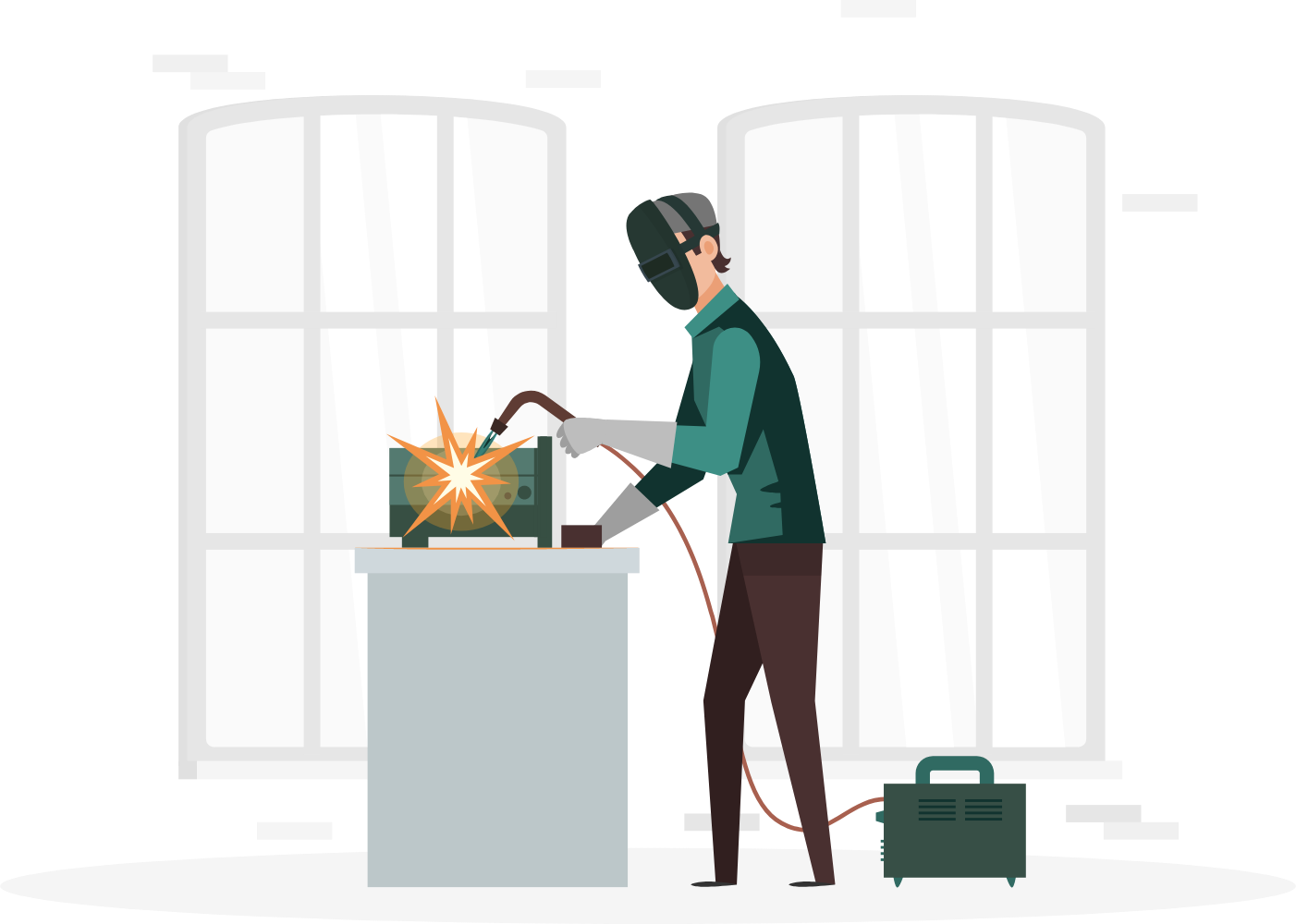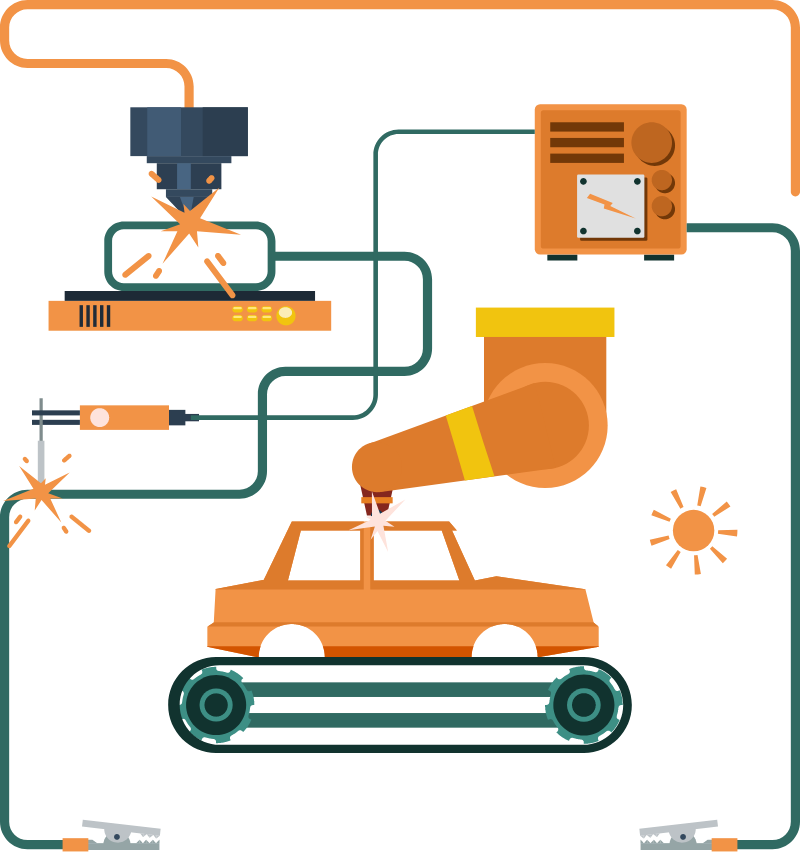6 Steps to Get a Welding Job With No Experience
Feel like welding is your vocation, and not sure where to start? Get the best insights for getting a welder job with no experience.
Feel like welding is your vocation, and not sure where to start? Get the best insights for getting a welder job with no experience.

Welders will always be in demand. Even while the whole world cuts production jobs in crisis, the existing transport arteries, machinery, and municipal supply networks will require maintenance and repair. Spending time on learning and becoming a professional pays back by stable employment and fair compensation. That is why welding is one of the best career choices at a time of economic instability. In this article, you will find out how to get into welding without experience, obtain the required skills and certifications, and successfully pass the hiring process.
TOP industries for a welding job
Welding is traditionally associated with Construction and Infrastructure. However, it is highly in demand for many other industries. Economists call it ‘a driving force of a modern economy’ because more than 50% of products manufactured in the USA involve welding. According to the U.S. Bureau of Labor Statistics, most welders work in the following areas:
- Railroad rolling stock manufacturing
- Fabricated metal product manufacturing
- Machinery
- Motor vehicle body and trailer manufacturing
- Ship and boat building
The salaries for welders vary from almost $40,000 to $90,000 per year. If you want a higher wage, choose one of these industries to get a welding job:
- Scheduled air transportation
- Gas distribution
- Energy development
- Petroleum and coal products manufacturing
- Pipeline transportation

Education and skills for a welding job
The BLS report for welders, cutters, solderers, and brazers states that by 2029 the demand for these professions will grow by 3%. The best way to get into a welding career with such a slow employment growth rate is undergoing a welder’s vocational training course, obtaining an up-to-date welding certificate, and mastering the necessary skills for the chosen role.
Diplomas and certifications
In welding, vocational training is more important than general education. Most employers prefer a high school diploma or GED. If you are a high-school student, you can attend welding courses at your school. If you’re a post-graduate, there are post-graduate training programs for welders arranged by AWS-certified centers. The AWS (American Welding Society) itself also offers courses in its local chapters.
Earlier, anyone could become a welder without professional education: welders obtained all needed skills and knowledge by training-at-work. Today every welder needs to pass professional tests to get a certificate to confirm their qualifications and be eligible for hire. Often on-the-job training doesn’t provide enough theoretical knowledge to pass the certification tests successfully. There are lots of questions from physics, chemistry, and other disciplines. That is why applying for a certified training program is the most reasonable approach to get a proper professional education.
Usually, welding courses take up to 24 months. Some of them are government-sanctioned and offer student loans to pay for education. Others are commercial and require paying upfront. The cost of welding training programs varies depending on the duration and the scope of disciplines. After course completion, you will be able to earn a welding certificate. The certification price from the American Welding Society starts from $75.
Further, you can begin working as a welder or continue education and pursue a BA in Welding. Proper welding education and certificates also help get a good welding job overseas if you decide to develop a career in Europe or Asia. Most foreign employers are looking for qualified specialists and will assist in obtaining local certificates required by their country’s industry standards.
What skills are must-have for welders?
Before deciding to connect your life with a welding job, realize that it is a physically challenging occupation. It requires hard physical work, often in severe conditions. Besides good health and high endurance, you will need the following skills:
- Physical capabilities:
- Close vision
- Hand-eye coordination
- Manual dexterity
- Depth perception
- Mathematical skills:
- Calculating dimensions
- Reading sketches and blueprints
- Reading 2- and 3-dimensional graphics
- Attention to details:
- Full adherence to safety standards
- Precision in cutting metal objects, joining parts, etc.
- Complete following the directions.
- Soft skills:
- Problem-solving
- Strong communication
- Team mentality
- Accountability
- Interpersonal skills
How to find a welding job in 6 steps?
As reported by Forbes, job searches can take an average of 5 months. However, the exact duration is always challenging to predict. Nevertheless, you can still do everything in your power to bring the coveted job offer closer. For this purpose, follow these six steps:
1 Focus on practice
If you are looking for how to get a welding job with no experience, a perfect combination for beginners is technical school combined with further practice in a real environment. You have two options to go with after training courses and certification:
- Apprenticeship
- Internship
Both an internship and apprenticeship provide hands-on experience in a real environment but offer different approaches. Apprenticeships pay you for practicing and learning until you get enough skills to work as a full-fledged welder. Internships usually are not paid. Being an intern means working for free until you get all the necessary skills for the position. This practice helps to understand modern requirements and receive appropriate knowledge while you’re in contact with mentors.
Employers usually hire interns for a few weeks or months with no salary. Suppose you doubt that welding is your calling. In that case, an internship is an excellent opportunity to evaluate this career path and decide.
Apprenticeship is a type of formal employment with a somewhat lower salary. You will sign an apprenticeship contract for 1 to 6 years. At the end of this period, you will have the formal qualifications to work in a chosen field. It is a common practice for construction and manufacturing industries and a good option for those who have already decided to develop a welder career.
2 Build your resume
A properly thought-out welder’s resume is vital for your job application to catch the recruiter’s attention. We’re living in the digital era. That is why your resume should be perceptible for both humans and the automated applicant tracking systems (ATS). As stated by CNBC, 75% of resumes are never seen by humans. However, you can surpass this barrier with ease.
ATSs sort out resumes by detecting position-specific keywords. If a resume contains the target word triggers, the system considers it as matching. For a welder job, the most popular keywords include:
- Welder
- Welding
- Cutting torches
- Blueprint reading
- ASME certified
- AWS certified
- Solid-state
- Stick
- Arc/TIG/MIG (the abbreviations of welding technologies)
Make sure to include as much welding keywords as possible without affecting the overall resume structure and readability. If you want to create a customized resume that complies with all modern content, style, and formatting requirements, use the GetCoverLetter professional resume builder.
3 Write a cover letter to support your job application
While there are strict requirements for a resume structure and content, a cover letter is written in a more informal manner and may contain any information to tilt the odds in your favor. It should outline your motivation to take a position and the value you can bring to the company that hires you. Yahoo Finance reports that a great cover letter convinces 83% of hiring managers to offer an interview. Even if you applied for an online job listing, in 64% of cases, a cover letter is considered a must-have. Otherwise, your application may be ignored.
A good cover letter fills up your job application with enthusiasm and motivation towards the future profession. Here are the tips on how to make it shine:
- Begin with a nice-looking header with your contact details in the right place—this way, a hiring person will quickly find ways to get in touch with you. Check our guide on how to start a cover letter.
- Never address your cover letter impersonally. Only personal cover letters get the desired response. Use the name of your hiring manager or employer. If you have no names, address your cover letter to the position of the reader. For instance, “Dear Hiring Manager”.
- Use short paragraphs to express your thoughts. The first paragraph should grab the reader’s attention. The second one explains what you offer. The third proves your perfect suitability for the position.
- Don’t exhaust your employer with lengthy cover letters. The right size is about 200-300 words.
- Finish your cover letter, politely. Never close it with familiar or slangy goodbyes like ‘Cheers,’ ‘With love,’ ‘Peace out.’ ‘Respectfully,’ ‘Kind regards,’ ‘Thank you’ is much better.
- Formatting is the king. Remember that the same text can be perceived in different ways, depending on how nice it looks. Format your cover letter correctly to make it comfortable and pleasant for reading.
- If you struggle with what to write in a cover letter or how to lay it out, use the GetCoverLetter builder. It will save a lot of your time without compromising the quality of your self-presentation.
4 Find suitable job openings
There are multiple sources for welder job search. If you want to find the job of your dreams as fast as possible, pay attention to each:
- Online job boards
- Local welding societies and their websites
- Social media
- Employers’ websites and offices
- Networking
Surf the internet to sort out the job openings posted online. If you are interested in working for specific companies, visit their corporate websites to see if any welders are wanted. Even if you find no information about the open jobs, contact the company representatives directly using the website’s contact details. Perhaps there is a vacancy that was not opened publicly. If you wish to get hired in some local area, search for the firms located there, contact them online or via phone, or visit their offices in person.
Networking is another channel for getting a job as a welder. Running around the professional community online and offline with clear job search intentions attracts interested employers and gives you access to a hidden job market. Use every chance for an active job search to observe all available opportunities for getting hired.
5 Apply for welding jobs correctly
Every application you send should be customized and relevant to the job opening requirements. Don’t send tons of bulk applications. Read the job description carefully and make sure your resume and cover letter contain all the necessary information an employer asks for. Explore what skills, personality traits, experience, and education a particular employer requires and reflect them in your application documents to prove your suitability for the position.
Don’t be upset if you’re not getting invitations to interviews immediately. The latest Statista report shows that an average time-to-hire in manufacturing and professional services is 38-40 days. It takes time to sort out the best candidate, review application documents, and decide to adopt an interview. Based on GetCoverLetter’s research, a job seeker needs to send 10-27 applications to get one invitation to the interview. Be patient and proactive: don’t stop searching and applying until you get the desired result.
6 Get ready for an interview
When going to the interview for a welder position, be ready for a practical examination of your skills. It is not an office job interview. Here your hands may speak more cogently. There are a few essential tips to gain success.
- Know the company you’re going to. You should be well aware of your employer’s professional profile and demonstrate your awareness during the interview. It also helps to feel less nervous if you know more about the hiring company.
- Carefully learn the job description. If there are specific types of welding mentioned, make sure you possess the right technologies and be able to answer questions about them.
- Practice answering typical interview questions before the meeting. You cannot foresee all questions that will be asked, but it will help to feel more confident and find the right points for conversation.
- Consider clothing for your interview. Very often, interviewers ask potential welders to demonstrate their hands-on experience as a part of an interview. Therefore, Take some workwear to change for practical examination.
Usually, it takes up to a few weeks to hear back after the interview. But you can always send a follow-up email asking about the employer’s decision.
Welder career tips
Here are some additional tips for getting steady employment as a welder.
- When observing the job boards, look through different categories. Welder openings are usually available under ‘Skilled trades,’ ‘Construction,’ ‘Manufacturing,’ ‘Repair and maintenance,’ ‘General labor,’ and ‘Industrial technology’ categories.
- Don’t focus on learning one specific welding technique, as it limits your professional potential. Employers often look for multi-process welders.
- Pipe welding generally pays higher than structural welding. However, it is also harder. Weigh your efforts-expectations ratio when deciding what type of welding to choose for learning.
- If you’re a beginner, consider buying an entry-level welding machine to practice your skills at home. You should gain as much hands-on experience as possible.
- Join professional organizations like AWS and actively participate in their local activities. It will make you aware of the up-to-date job trends, expand your professional contacts network, and increase hiring chances.
- If you currently have low to no income, check for the available government-supported or non-profit training programs to learn to weld.
Conclusion
Welding opens the doors to numerous industries, from housekeeping maintenance to high-tech spaceship engineering and jewelry. We hope that our tips will get you closer to your dream position. But remember that your perseverance and sincere desire to unlock your potential in this profession also matters. Therefore, always keep your goal in mind, no matter what difficulties you encounter on your way.

